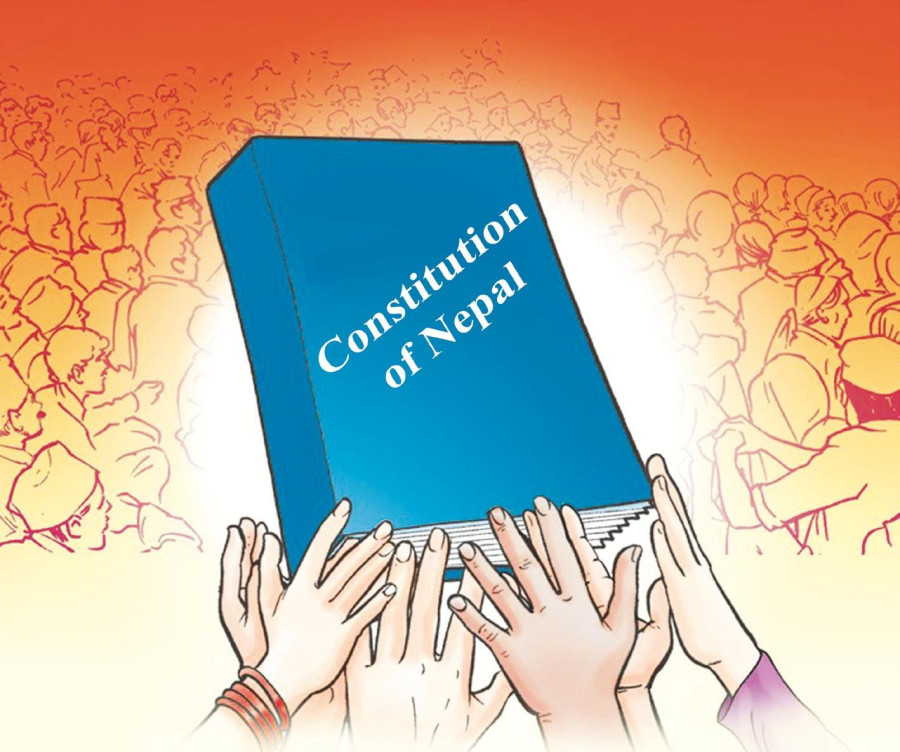Columns
Our constitution, our guide
Only through collective efforts can we realise the full potential of the hard-won federal system.
Khim Lal Devkota
Today, Nepal celebrates its ninth Constitution Day, marking a significant milestone in the country's journey as a federal democratic republic. The Constitution of Nepal is a visionary document that aims to eradicate all forms of discrimination while actively promoting prosperity, social justice and good governance. These principles are intricately woven into the fabric of the constitution, encompassing the principles of federalism, republicanism, secularism, proportional representation and the rule of law.
Since Nepal adopted federalism, significant achievements have marked the country's political and governance landscape. The establishment of sub-national governments represents a fundamental milestone in this transition.
One of the critical accomplishments is the constitutionally mandated proportional representation system across all levels of governance. Nepal has achieved a remarkable 34 percent representation of women in Parliament. At the local level, women's representation reaches an impressive 42 percent. These figures demonstrate a commitment to gender equality and empowerment within the federal framework.
Civil servants
Furthermore, the structural overhaul of the previous governance system has resulted in the redeployment of over half of Nepal's 100,000 civil servants to the sub-national levels. High-ranking civil servants, once predominantly concentrated in Kathmandu and other urban centres, have now been dispersed to sub-national regions. This decentralisation of administrative power not only brings government services closer to the people but also signifies a significant transformation. Local level elections, which had been suspended for two decades, were finally made possible through federalisation.
Despite the challenges, the sub-national governments have made visible progress. The local levels have significantly increased their internal revenue from less than Rs10 billion in the pre-federalisation period to approximately Rs50 billion today. This surge in revenue generation has enabled local governments to create budgets exceeding Rs1 billion, marking a qualitative leap in development and service delivery. The decentralisation of resources and budgets has empowered the sub-national levels to drive their own development agendas.
Another critical impact of federalism is the return of peace to the nation. During the conflict period, countless rural residents were displaced from their homes, a trend that continued during the Madhesh movement. Federalism has been pivotal in restoring peace and fostering self-reliance among the population. Citizens no longer need to travel to the district headquarters or the capital for basic government services.
Federalism has also addressed the issue of representation, reducing the dominance of certain castes and communities in the state machinery. There is now healthy competition among the sub-national levels in areas such as development, construction and service delivery, which was lacking before federalisation.
Despite these advancements, challenges persist. Delays in passing civil service and education laws and the need for efficient resource management continue to be issues. Coordination among different levels of government, especially in law formulation and resource allocation, remains a work in progress. Similarly, the adjustment of the police security force at the provincial level has yet to be completed. The sub-national governments, particularly the provinces, have not fully experienced the extent of government power. Addressing these challenges is crucial to ensuring the success of federalism.
Regardless of the governance system in place, the ultimate goals remain development, prosperity and good governance, with peace being of paramount importance. Without peace, no legal framework can effectively function. Therefore, our focus should shift towards creating a more cost-effective and adaptable system.
For federalism to succeed, the federal government must not hesitate to provide robust support for personnel management, institutional development, planning and budgeting implementation, and legislative processes at the sub-national levels. Simultaneously, the sub-national entities must also demonstrate a sincere commitment to the effective implementation of federalism. Only through collective and dedicated efforts can we realise the full potential of our federal governance system.
It is vital to acknowledge that the 2015 Constitution did not emerge without significant struggles and hardships. Movements such as the decade-long Maoist insurgency, the People's Movement of 2006, and various other communal uprisings paved the way for the constitution's birth. The Nepali people's resolute dedication to democracy and progressive change propelled these movements and, ultimately, the constitution itself.
Federalism does not guarantee immediate prosperity or democracy. Instead, it serves as a powerful tool that empowers the sub-national levels of government and fosters inclusive development.
The time has come for Nepal to not only safeguard the constitution but also actively work toward realising the full potential of federalism. This journey demands diligence, cooperation and a shared vision for a prosperous and just Nepal.
Exit policy
In conclusion, the journey into federalism has yielded remarkable achievements for Nepal. From empowering women and marginalised communities to promoting self-reliance, decentralising resources, and most importantly, restoring peace, federalism has had a profound impact on the nation. While it comes with its challenges and costs, the dividends in terms of improved governance, representation and quality of life for the citizens are clear indicators of its success.
To ensure the stability of this constitution and federal system, we need an "exit policy" for political party leaders from the state structure, particularly the prime minister, ministers and members of parliament. Switzerland limits the tenure of the president and the house speaker to just one year, without the possibility of repetition. Members of parliament are not allowed to become ministers; instead, they need to be elected from within parliament. They are also prohibited from receiving salaries or similar benefits from parliament. Moreover, the number of ministers, including the president, is limited to seven individuals. These practices prioritise better public services, providing valuable insights for constitutional and federal reform.




 8.12°C Kathmandu
8.12°C Kathmandu















